Home | Highlights
of the
Collection | Search Collection
COLLECTION
>
Highlights of the Collection
> Search Collection
Highlights
of the
Collection
The Godwin-Ternbach collection of over 5,000 objects from antiquity to the present represents art and artifacts in all media from all periods and cultures, Western and non-Western. Works from the major areas of Painting, Sculpture and Decorative Arts, Prints and Drawings, and Ethnographic Arts are offered here in chronological order, from ancient to modern times. |

1

2

3

4
|
|
Within
the Museum’s walls are many small hidden treasures
that require us to look closely and carefully at their
workmanship and beauty. In the mysterious representations
of gods, charms, and amulets painted on the Fragment
of an Egyptian Sarcophagus (1),
or an Etruscan bronze Votive Figure, we see a
glimmer of lost
civilizations (2).
The fearsome face of the marble Mask of Silenus (3),
a part bestial, part human creature of Greek mythology,
once warned of the dangers of intemperance and insatiable
appetite from its original placement high on a building
façade. From the ancient nomadic Luristan culture
of Iran come any number of objects with images of horses,
while the intricate design of a bowl from the later Seljuk
period is fashioned in the shape of a melon (4).
All reflect the veneration of nature and the animal kingdom
common to all ancient cultures.
|

5
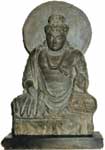
6

7
|
|
Other
works offer more familiar symbolic images. The exquisite Descent
from the Cross (5),
a leaf from a diptych carved in ivory by an anonymous 14th-century
master,
attests to the
plaintive
truth of sacrifice and the glory of spiritual devotion.
The serene presence of the carved stone Bodhisattva (6) from
Gandara, India makes the benevolent wisdom of Buddhist
teaching visible, while the joyous spirit of
pre-Columbian
America is preserved in the tiny figure dancing atop a
terracotta “Stopless” Flute (7) from
Veracruz, Mexico.
|

8

9

10
|
|
Numerous
Renaissance works inspired by the classical world grace
the collection. The beautifully crafted figurine of Atlas
Crouching (8), who shoulders the
burden of the globe, is one from a significant group of
Italian bronzes. Albrecht
Dürer’s contemplative engraved portrait of Erasmus
of Rotterdam (9), the philosopher
who brought enlightenment to the North, is but one example
from our exceptionally
fine collection of 15th to 20th century prints. A spare,
masterful drawing by Rembrandt of Christ on the Mount
of Olives (10) is a true highlight
of the drawings collection.
|

11
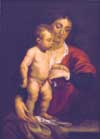
12

13

14
|
|
Among
our paintings from the 15th to 17th centuries, are works
by important masters and workshops, like the lovely Madonna
and Child with Fruit (11) by
Veronese painter Santa Creara or the tender Madonna
and Child from the workshop
of Peter Paul Rubens (12),
both of which cloak Christian doctrine in the virtuoso
naturalism of Renaissance style.
Dutch Horseman’s Game (13) by
Baroque painter Philips Wouwerman, a student of the great
Dutch master
Jacob van
Ruysdael, is an icon of the Reformation’s secular
realism. Devoid of religious significance, it revels in
a “game” of the period—“skinning
the cat”—where the representation of equestrian
skill and bravura technique of the painter belie the harsh
realities of the image and of life
in
those times.
It is also one of the rare Wouwerman’s in an American
collection. Similarly, the magnificent Christ Carrying
the Cross (14) by
Venetian Baroque artist Paris Bordone, is as fine an example
as any of that master, and one of
the few in this country.
|

15
|
|
The
charming Fête Galante (15) of Rococo painter
Nicolas Lancret pictures courtly entertainment prior to
the demise
of the aristocratic world in the French Revolution. Successor
to Jean-Antoine Watteau, Lancret decorated the interior
of Versailles under the patronage of Louis XV. The painting,
set in an elaborate original frame with a delicate molded
wooden bow at the top, epitomizes the 18th century’s
veneration of the feminine and is one of a pair in our
collection.
|

16
|
|
In
the 19th century, the visual and emotional realism of Renaissance
and Baroque artists resurged in the work of Romantics like
Antoine-Louis Barye, the finest of the French animaliers sculptors. Jaguar Devouring a Hare (16), considered
his masterpiece, displays a similar passion for violence
and
truth to nature as Dutch Horseman’s Game, but removes
man as privileged subject and center of the universe.
|
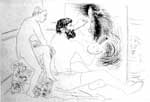
17
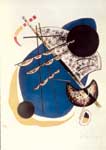
18

19
|
|
Modernists
works, primarily from the print collection, illustrate
the revolutionary color, form, and content developed by
artists of the Symbolist, Impressionist, Expressionist,
Cubist, Surrealist, and Pop art movements. Near the turn
of the century, new attitudes and materials freed artists
to experiment and produce a new kind of art. Works by Daumier,
Whistler, Morisot, and Lautrec signal a radical simplification
and distortion of image that emerged in the 19th century
and climaxed in the work of Picasso, Braque, Matisse, Rouault,
and Pechstein in the 20th century. In Picasso’s Peintre
Travaillant (Painter Working) (17),
figure, ground, and space are reduced to essentials through
the use of
nothing
more than line. Kandinsky’s Kleine Welten II (Small
Worlds II) (18) is
a paradigm of modern abstraction in its use of form and
color to symbolize content and emotional
states. These strategies upset all definitions of subject
matter and representation that had dominated since the
Renaissance. By the mid-20th century, with the rise of
media, advertising, and post-industrial culture, art had
become a cause for celebration of popular culture, and
tongue-in-cheek productions like Andy Warhol’s famous
Soup Can series (19) turned
sacred and romantic myths and styles of art and artists
on their head.
|

20
|
|
The
art of non-Western cultures was a catalyst for the change
that took place in modernist art. The detail of the lovely
geisha from Utagawa Kuniyoshi’s Autumn Triptych (20) reveals many of the qualities admired by the moderns—a
flattening of space and abandonment of perspective to favor
rhythms of line and emphasize pattern and surface; absence
of modeling in light and shadow to create a three-dimensional
illusion; decorative, unnaturalistic use of color; and
unusual angles of vision that dramatize composition and
content.
|

21

22
23
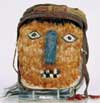
24
|
|
These
qualities and a preference for abstract and symbolic form
and content are found globally in the creations of other
traditional cultures from Asia (21) to Africa (22),
the Pacific (23) and
Native America. (24)
|
We hope this introduction serves as an invitation to explore our Museum without walls—here on the website—as well as to come and enjoy the real objects in our galleries.
|
> Back
to top
|




